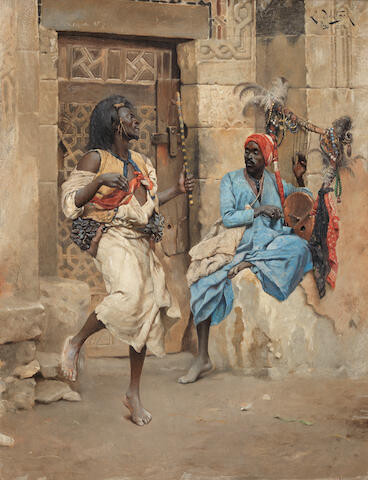Ludwig Deutsch, (Austrian, 1855-1935)
The Performance
The Performance
signed, inscribed and dated 'L. Deutsch/PARIS 1885' (upper right)
oil on panel
40.6 x 30.5cm (16 x 12in).
Provenance
Arthur Tooth & Sons, Paris.
M. Newman Ltd., London.
Private collection, UK (acquired from the above 6 April 1970).
Thence by descent.
In the present lot Deutsch illustrates an African dancer, caught mid-step during his energetic routine. Deutsch's reliance on photography to achieve such hyper-realistic effects – he is known to have frequented the well-known studio of G. Lékégian in Cairo – is here evident, as is his extraordinary skill as an ethnographer. The cowry shells adorning the waist of the dancer would, as Deutsch knew from personal experience and his virtual library of literary references, have held special meaning in Egyptian culture, as a protective against the evil eye, and the distinctive hairstyle of the man would have immediately identified him as of Nubian origin. In addition to the Description de l'Egypte (1809-29) still widely available in Paris at this time, Deutsch also drew regularly from illustrated newspapers, Edward William Lane's iconic An Account of the Manners and Customs of the Modern Egyptians (London, 1836), Owen Jones's The Grammar of Ornament (London, 1856), and Georg Ebers' Egypt: Descriptive, Historical, and Picturesque, published in German in 1878 and illustrated by Deutsch's compatriot and acquaintance Leopold Carl Müller.
The musician by the dancer's side is equally remarkable. The elaborate instrument he strums is an archaic Arabic simsimiyah or kisser, bedecked with ostrich feathers, amulets, and beads, and still used in Egypt today. Deutsch's appreciation of local music is made clear through several other pictures in his oeuvre, and may have been inspired by the revival of interest in Europe in historical music and, at the same time, in 17th and 18th century Dutch genre painting. So too, Deutsch may have been capitalising on an established and popular theme among Orientalist painters, who often portrayed male and (more commonly) female performers in the midst of their mesmerising routines.
We are grateful to Emily M. Weeks, Ph.D for compiling this catalogue entry.
The work will be included in a critical catalogue of the Orientalist work of Ludwig Deutsch currently in preparation by Emily M. Weeks, Ph.D.
View it on
Sale price
Estimate
Time, Location
Auction House
The Performance
The Performance
signed, inscribed and dated 'L. Deutsch/PARIS 1885' (upper right)
oil on panel
40.6 x 30.5cm (16 x 12in).
Provenance
Arthur Tooth & Sons, Paris.
M. Newman Ltd., London.
Private collection, UK (acquired from the above 6 April 1970).
Thence by descent.
In the present lot Deutsch illustrates an African dancer, caught mid-step during his energetic routine. Deutsch's reliance on photography to achieve such hyper-realistic effects – he is known to have frequented the well-known studio of G. Lékégian in Cairo – is here evident, as is his extraordinary skill as an ethnographer. The cowry shells adorning the waist of the dancer would, as Deutsch knew from personal experience and his virtual library of literary references, have held special meaning in Egyptian culture, as a protective against the evil eye, and the distinctive hairstyle of the man would have immediately identified him as of Nubian origin. In addition to the Description de l'Egypte (1809-29) still widely available in Paris at this time, Deutsch also drew regularly from illustrated newspapers, Edward William Lane's iconic An Account of the Manners and Customs of the Modern Egyptians (London, 1836), Owen Jones's The Grammar of Ornament (London, 1856), and Georg Ebers' Egypt: Descriptive, Historical, and Picturesque, published in German in 1878 and illustrated by Deutsch's compatriot and acquaintance Leopold Carl Müller.
The musician by the dancer's side is equally remarkable. The elaborate instrument he strums is an archaic Arabic simsimiyah or kisser, bedecked with ostrich feathers, amulets, and beads, and still used in Egypt today. Deutsch's appreciation of local music is made clear through several other pictures in his oeuvre, and may have been inspired by the revival of interest in Europe in historical music and, at the same time, in 17th and 18th century Dutch genre painting. So too, Deutsch may have been capitalising on an established and popular theme among Orientalist painters, who often portrayed male and (more commonly) female performers in the midst of their mesmerising routines.
We are grateful to Emily M. Weeks, Ph.D for compiling this catalogue entry.
The work will be included in a critical catalogue of the Orientalist work of Ludwig Deutsch currently in preparation by Emily M. Weeks, Ph.D.



